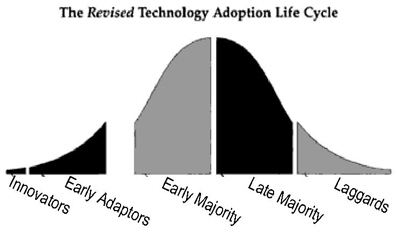
In response to the suggestion that the the number of abandoned blogs one comes across these days signals that “the (law) blogging phenomenon may have peaked“, Kevin O’Keefe is right on when he says that “Nothing could be further from the truth. Law blogs are in their infancy.”
Other business-minded bloggers agree:
Justin Patten believes “We really are scratching the surface at the moment.”
Shel Israel, co-author of Naked Conversations, the book on business blogging, says:
blogging is growing up and to understand what we face, people should circle back and read or reread Geoffrey Moore’s brilliant Crossing the Chasm. The blog marketplace is acting a bit like a bubble. But the real relevance, seems to me to be that we have saturated the early adopters in three markets–geeks, politico’s and American youth. Word of mouth has generated all that, and now there’s probably 100 million people in the world enthusing or complaining about blogs.
Crossing the Chasm concerns the marketing of tech products. The chasm referred to relates to the the Technology Adoption Lifecycle. The adoption or acceptance of a new product or innovation follows a classical normal distribution or “bell curve.” The first group of people to use a new product are the “innovators,” followed by “early adopters”, then the early and late majority, and finally the “laggards”. Moore revises this for discontinuous or disruptive innovations: there is a “chasm” between the first two adopter groups (the innovators and adopters) and the early majority.

Israel continues:
The question is can blogging and the social media, leap the chasm from these significant but niche communities and land into the big oceanic repository created by the mainstream. I see lots of evidence that that is the case.
When I look at blogging I see it from two angles:
- An application of technology: a very effective, standardised publishing format that has already proved its worth and crossed the chasm for significant niches (with 55 million blogs published, who can argue with that?)
- A culture. This is the interesting part. The majority looks at the blogosphere and sees a world of geeks, exhibitionists and soap box artists and wonders what relevance can it have for them. To cross the chasm blogging needs to become a normal business tool.
Israel argued a year ago that “the blog is starting to become part of the business normal“:
just as email and the Internet did. Both of these early disruptive innovations are now boring because they are so much of the usual business routine. It was not all that long ago that having a website, or allowing employees to email on company time were highly controversial with legal departments fretting the repercussions just as they do today over blogging.
The blog, it seems to me, is becoming just another brown cow. This again, is a good thing. First comes the excitement, then comes the prolongs inevitable change. This is what is supposed to happen. New things need to normalize if they are to endure if they are to really and truly change corporate communications.
Various drivers will ensure blogging becomes normal business practice, inter alia: established publishers are producing blogs; marketing people are using them; established content management systems are incorporating blogging features. In five years’ time blogging will be as normal for businesses as having a website is today. The culture will have changed: blogging will on balance be less geeky, less chummy, more commercialised. This mirrors what happened to the web itself ten years ago.
Nice pick up Shel’s use of Crossing the Chasm, shared it with my readers this am.